PUBH632: Ministerial Briefing on Safe Injecting Rooms
VerifiedAdded on 2022/11/10
|9
|2453
|314
Report
AI Summary
This briefing note, prepared by a Senior Policy Officer for the Minister for Health, addresses the critical role and impact of Safe Injecting Rooms (SIRs) in Australia. It provides a comprehensive overview of the current situation, citing statistics from studies like Insite (2016) and the Medically Supervised Injecting Centre in Sydney, highlighting the significant number of drug users, the drugs most commonly used, and the positive impact of SIRs in reducing overdose deaths and promoting access to treatment. The report addresses key issues and concerns, particularly those stemming from the government's zero-tolerance drug policy, and presents policy options, emphasizing the provision of safe environments, trained medical staff, and the potential for disease prevention and overdose intervention. The briefing concludes with recommendations for the Minister, advocating for the inclusion of trials of SIRs in Australia’s Drug Strategy, legislative frameworks within the Controlled Drugs and Substances Act, and a bottom-up approach to policy implementation, ultimately aiming to facilitate proper and clean use of health services and minimize harm associated with injection drug use.

TO: MINISTER FOR HEALTH – FOR ACTION
FROM: SENIOR POLICY OFFICER, AAA DIVISION
DATE: xx SEPTEMBER 2019
SUBJECT: SAFE INJECTING ROOM
PURPOSE:
1. To brief you on the importance of Safe injecting rooms. This Briefing will offer the
necessary advice on how to establish such kinds of premises in the healthcare industry.
BACKGROUND
2. A study conducted by Insite in 2016 shows that there are currently more than 150,000
drug users In the Australian Jurisdiction. Moreover, there about 350,000 annual visits to
the SIRs with a record of 13,000 unique users every month. Some of the mostly used
drugs include Heroin (40% of all cases), Cocaine (29%) and lastly Morphine and 12% of
all users. In addition, 17% of all users were Identified as Aboriginals (Potier, et al.,
2014).
3. This information shows astounding statistics for a project that has been receiving such
huge legal opposition and has been a huge subject of debate in the recent past (Bravo, et
al., 2009). By looking at the statistics, there is a key relationship that ought to be pointed
out between the number of unique number of individuals that have been visiting such
establishments across the country and the number of patients that have been sent to
various social and health care services for further treatment (Herrmann, et al., 2012). It is
evident that the number of SIR users has been on the rise with approximately 5,268 users
since 2017 up to date (Supervised, 2011).
FROM: SENIOR POLICY OFFICER, AAA DIVISION
DATE: xx SEPTEMBER 2019
SUBJECT: SAFE INJECTING ROOM
PURPOSE:
1. To brief you on the importance of Safe injecting rooms. This Briefing will offer the
necessary advice on how to establish such kinds of premises in the healthcare industry.
BACKGROUND
2. A study conducted by Insite in 2016 shows that there are currently more than 150,000
drug users In the Australian Jurisdiction. Moreover, there about 350,000 annual visits to
the SIRs with a record of 13,000 unique users every month. Some of the mostly used
drugs include Heroin (40% of all cases), Cocaine (29%) and lastly Morphine and 12% of
all users. In addition, 17% of all users were Identified as Aboriginals (Potier, et al.,
2014).
3. This information shows astounding statistics for a project that has been receiving such
huge legal opposition and has been a huge subject of debate in the recent past (Bravo, et
al., 2009). By looking at the statistics, there is a key relationship that ought to be pointed
out between the number of unique number of individuals that have been visiting such
establishments across the country and the number of patients that have been sent to
various social and health care services for further treatment (Herrmann, et al., 2012). It is
evident that the number of SIR users has been on the rise with approximately 5,268 users
since 2017 up to date (Supervised, 2011).
Paraphrase This Document
Need a fresh take? Get an instant paraphrase of this document with our AI Paraphraser
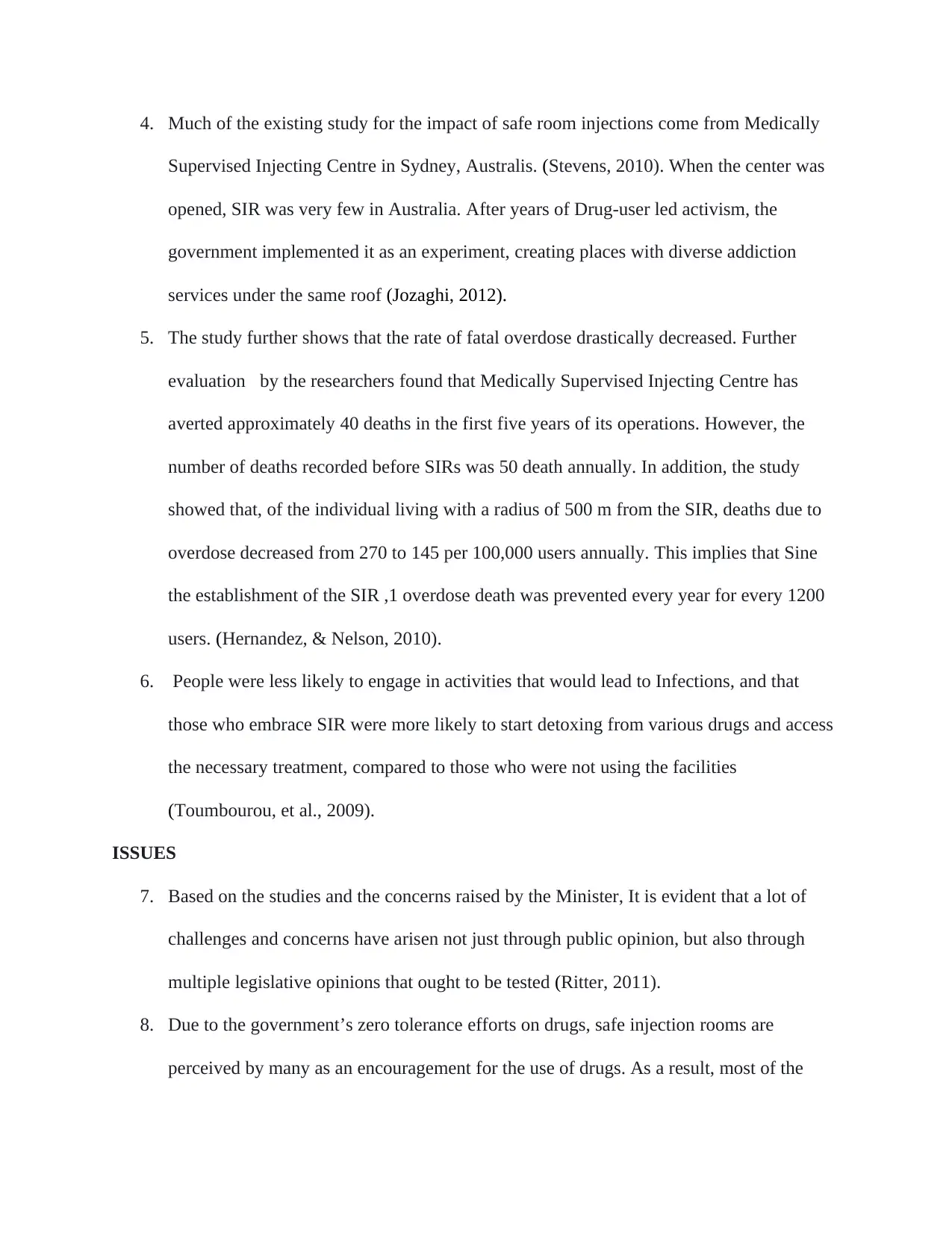
4. Much of the existing study for the impact of safe room injections come from Medically
Supervised Injecting Centre in Sydney, Australis. (Stevens, 2010). When the center was
opened, SIR was very few in Australia. After years of Drug-user led activism, the
government implemented it as an experiment, creating places with diverse addiction
services under the same roof (Jozaghi, 2012).
5. The study further shows that the rate of fatal overdose drastically decreased. Further
evaluation by the researchers found that Medically Supervised Injecting Centre has
averted approximately 40 deaths in the first five years of its operations. However, the
number of deaths recorded before SIRs was 50 death annually. In addition, the study
showed that, of the individual living with a radius of 500 m from the SIR, deaths due to
overdose decreased from 270 to 145 per 100,000 users annually. This implies that Sine
the establishment of the SIR ,1 overdose death was prevented every year for every 1200
users. (Hernandez, & Nelson, 2010).
6. People were less likely to engage in activities that would lead to Infections, and that
those who embrace SIR were more likely to start detoxing from various drugs and access
the necessary treatment, compared to those who were not using the facilities
(Toumbourou, et al., 2009).
ISSUES
7. Based on the studies and the concerns raised by the Minister, It is evident that a lot of
challenges and concerns have arisen not just through public opinion, but also through
multiple legislative opinions that ought to be tested (Ritter, 2011).
8. Due to the government’s zero tolerance efforts on drugs, safe injection rooms are
perceived by many as an encouragement for the use of drugs. As a result, most of the
Supervised Injecting Centre in Sydney, Australis. (Stevens, 2010). When the center was
opened, SIR was very few in Australia. After years of Drug-user led activism, the
government implemented it as an experiment, creating places with diverse addiction
services under the same roof (Jozaghi, 2012).
5. The study further shows that the rate of fatal overdose drastically decreased. Further
evaluation by the researchers found that Medically Supervised Injecting Centre has
averted approximately 40 deaths in the first five years of its operations. However, the
number of deaths recorded before SIRs was 50 death annually. In addition, the study
showed that, of the individual living with a radius of 500 m from the SIR, deaths due to
overdose decreased from 270 to 145 per 100,000 users annually. This implies that Sine
the establishment of the SIR ,1 overdose death was prevented every year for every 1200
users. (Hernandez, & Nelson, 2010).
6. People were less likely to engage in activities that would lead to Infections, and that
those who embrace SIR were more likely to start detoxing from various drugs and access
the necessary treatment, compared to those who were not using the facilities
(Toumbourou, et al., 2009).
ISSUES
7. Based on the studies and the concerns raised by the Minister, It is evident that a lot of
challenges and concerns have arisen not just through public opinion, but also through
multiple legislative opinions that ought to be tested (Ritter, 2011).
8. Due to the government’s zero tolerance efforts on drugs, safe injection rooms are
perceived by many as an encouragement for the use of drugs. As a result, most of the
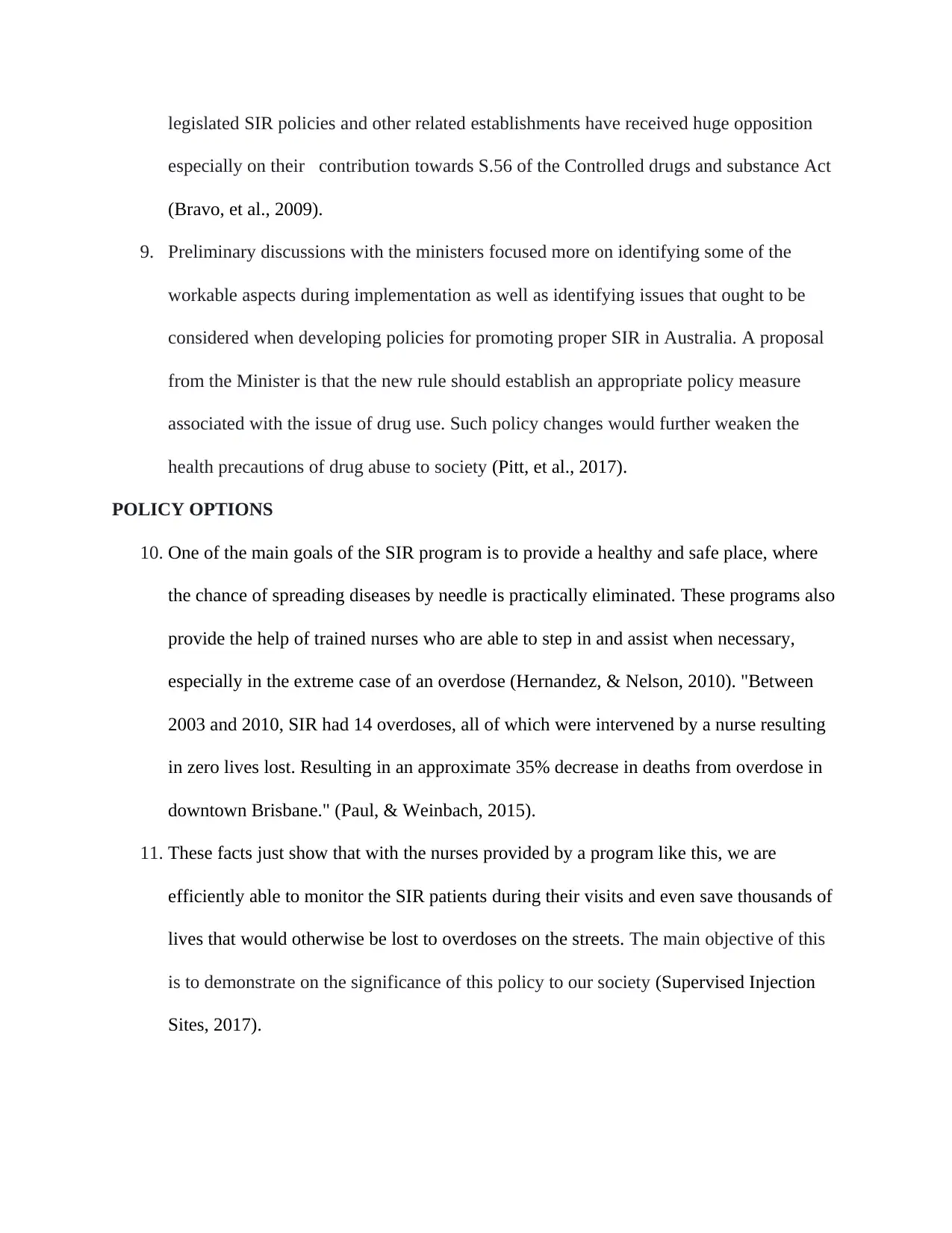
legislated SIR policies and other related establishments have received huge opposition
especially on their contribution towards S.56 of the Controlled drugs and substance Act
(Bravo, et al., 2009).
9. Preliminary discussions with the ministers focused more on identifying some of the
workable aspects during implementation as well as identifying issues that ought to be
considered when developing policies for promoting proper SIR in Australia. A proposal
from the Minister is that the new rule should establish an appropriate policy measure
associated with the issue of drug use. Such policy changes would further weaken the
health precautions of drug abuse to society (Pitt, et al., 2017).
POLICY OPTIONS
10. One of the main goals of the SIR program is to provide a healthy and safe place, where
the chance of spreading diseases by needle is practically eliminated. These programs also
provide the help of trained nurses who are able to step in and assist when necessary,
especially in the extreme case of an overdose (Hernandez, & Nelson, 2010). "Between
2003 and 2010, SIR had 14 overdoses, all of which were intervened by a nurse resulting
in zero lives lost. Resulting in an approximate 35% decrease in deaths from overdose in
downtown Brisbane." (Paul, & Weinbach, 2015).
11. These facts just show that with the nurses provided by a program like this, we are
efficiently able to monitor the SIR patients during their visits and even save thousands of
lives that would otherwise be lost to overdoses on the streets. The main objective of this
is to demonstrate on the significance of this policy to our society (Supervised Injection
Sites, 2017).
especially on their contribution towards S.56 of the Controlled drugs and substance Act
(Bravo, et al., 2009).
9. Preliminary discussions with the ministers focused more on identifying some of the
workable aspects during implementation as well as identifying issues that ought to be
considered when developing policies for promoting proper SIR in Australia. A proposal
from the Minister is that the new rule should establish an appropriate policy measure
associated with the issue of drug use. Such policy changes would further weaken the
health precautions of drug abuse to society (Pitt, et al., 2017).
POLICY OPTIONS
10. One of the main goals of the SIR program is to provide a healthy and safe place, where
the chance of spreading diseases by needle is practically eliminated. These programs also
provide the help of trained nurses who are able to step in and assist when necessary,
especially in the extreme case of an overdose (Hernandez, & Nelson, 2010). "Between
2003 and 2010, SIR had 14 overdoses, all of which were intervened by a nurse resulting
in zero lives lost. Resulting in an approximate 35% decrease in deaths from overdose in
downtown Brisbane." (Paul, & Weinbach, 2015).
11. These facts just show that with the nurses provided by a program like this, we are
efficiently able to monitor the SIR patients during their visits and even save thousands of
lives that would otherwise be lost to overdoses on the streets. The main objective of this
is to demonstrate on the significance of this policy to our society (Supervised Injection
Sites, 2017).
⊘ This is a preview!⊘
Do you want full access?
Subscribe today to unlock all pages.

Trusted by 1+ million students worldwide
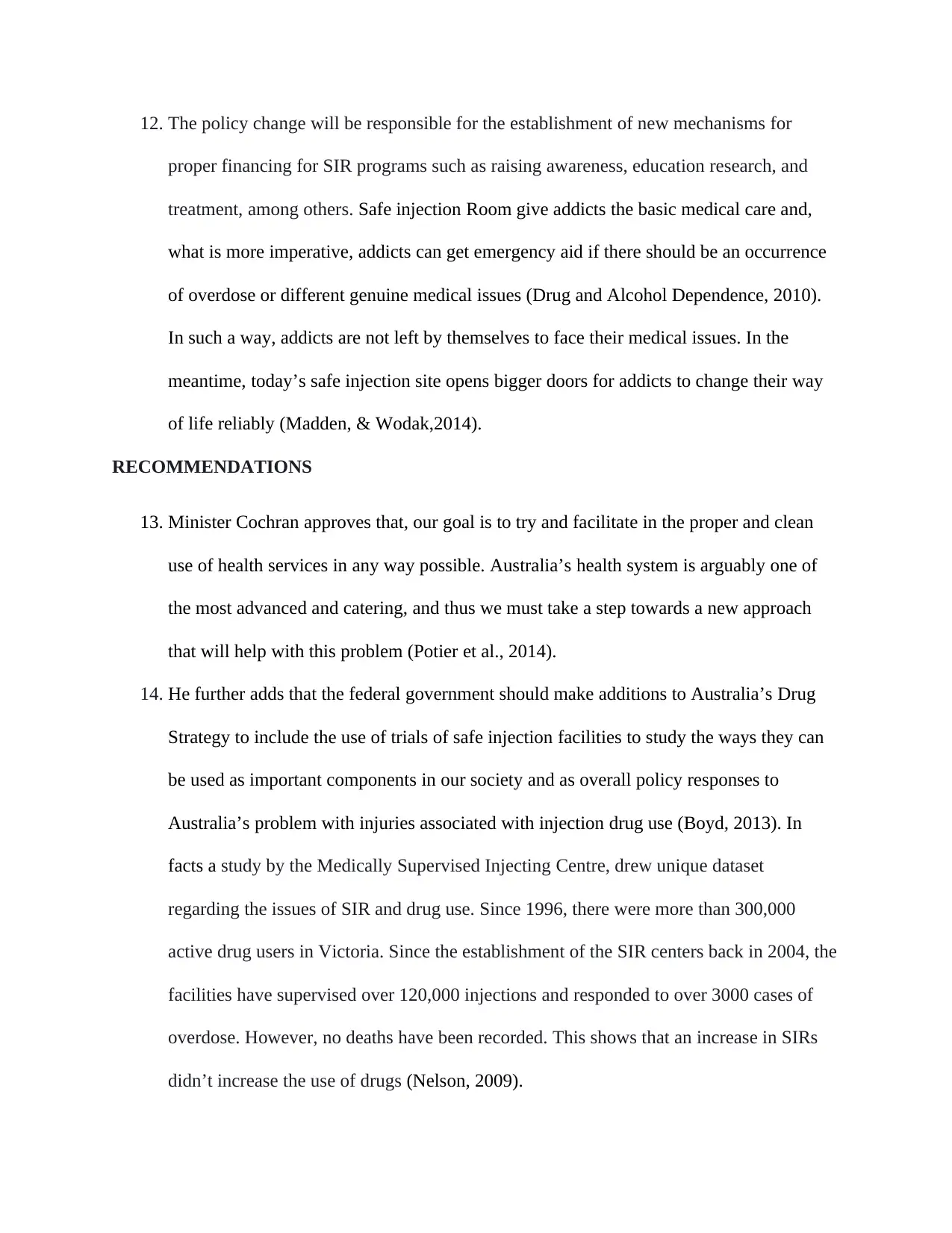
12. The policy change will be responsible for the establishment of new mechanisms for
proper financing for SIR programs such as raising awareness, education research, and
treatment, among others. Safe injection Room give addicts the basic medical care and,
what is more imperative, addicts can get emergency aid if there should be an occurrence
of overdose or different genuine medical issues (Drug and Alcohol Dependence, 2010).
In such a way, addicts are not left by themselves to face their medical issues. In the
meantime, today’s safe injection site opens bigger doors for addicts to change their way
of life reliably (Madden, & Wodak,2014).
RECOMMENDATIONS
13. Minister Cochran approves that, our goal is to try and facilitate in the proper and clean
use of health services in any way possible. Australia’s health system is arguably one of
the most advanced and catering, and thus we must take a step towards a new approach
that will help with this problem (Potier et al., 2014).
14. He further adds that the federal government should make additions to Australia’s Drug
Strategy to include the use of trials of safe injection facilities to study the ways they can
be used as important components in our society and as overall policy responses to
Australia’s problem with injuries associated with injection drug use (Boyd, 2013). In
facts a study by the Medically Supervised Injecting Centre, drew unique dataset
regarding the issues of SIR and drug use. Since 1996, there were more than 300,000
active drug users in Victoria. Since the establishment of the SIR centers back in 2004, the
facilities have supervised over 120,000 injections and responded to over 3000 cases of
overdose. However, no deaths have been recorded. This shows that an increase in SIRs
didn’t increase the use of drugs (Nelson, 2009).
proper financing for SIR programs such as raising awareness, education research, and
treatment, among others. Safe injection Room give addicts the basic medical care and,
what is more imperative, addicts can get emergency aid if there should be an occurrence
of overdose or different genuine medical issues (Drug and Alcohol Dependence, 2010).
In such a way, addicts are not left by themselves to face their medical issues. In the
meantime, today’s safe injection site opens bigger doors for addicts to change their way
of life reliably (Madden, & Wodak,2014).
RECOMMENDATIONS
13. Minister Cochran approves that, our goal is to try and facilitate in the proper and clean
use of health services in any way possible. Australia’s health system is arguably one of
the most advanced and catering, and thus we must take a step towards a new approach
that will help with this problem (Potier et al., 2014).
14. He further adds that the federal government should make additions to Australia’s Drug
Strategy to include the use of trials of safe injection facilities to study the ways they can
be used as important components in our society and as overall policy responses to
Australia’s problem with injuries associated with injection drug use (Boyd, 2013). In
facts a study by the Medically Supervised Injecting Centre, drew unique dataset
regarding the issues of SIR and drug use. Since 1996, there were more than 300,000
active drug users in Victoria. Since the establishment of the SIR centers back in 2004, the
facilities have supervised over 120,000 injections and responded to over 3000 cases of
overdose. However, no deaths have been recorded. This shows that an increase in SIRs
didn’t increase the use of drugs (Nelson, 2009).
Paraphrase This Document
Need a fresh take? Get an instant paraphrase of this document with our AI Paraphraser

15. The federal government needs to try and create some sort of framework in the Controlled
Drugs and Substances Act that will help legislate and safely govern the use of SIR
facilities (Kalant, 2010). This would not only help sanction the use of these programs,
but also give more freedom and liberty to the nurses and workers associated with these
programs. As of right now, since they are not government sanctioned/approved, those
aiding at SIR clinics are liable for any risks associated at the clinics (Jozaghi, 2012).
Both of these approaches/recommendations are vital to the success of such a health
policy, and for the greatest degree of success it would be suggested to implement both
strategies together to maximize effectiveness of the trial period (Horn, 2011).
16. Minister Cochran points out that the fact that SIR is a concurrent national and provisional
obligation makes reviews and assessment more difficult (Fitzgerald, 2013). He further
points out the economy cannot support the unchecked levels of drug use but must further
gauge its capacity to support the industry. In addition, section 56 of the Act ought to be
upheld because of its legitimacy and purpose in the modern society. (Nelson, 2009).
17. It is important to note that, this policy is based on a bottom-up process which Horn, J.
(2011) describes as a policy that is amended as it is implemented by the 'shop floor'
workers. What this is saying is that we need to look towards the basics, instead of trying
to govern from the top, and simply try and ban all use of illegal substances, we need to
look and accommodating society, and looking at ways to minimize the harm done in
general (Salmon, et al., 2010).
Prepared by: Senior Policy Officer,
AAA Division
Ext:
Approved by: CCC DDD, Secretary,
Drugs and Substances Act that will help legislate and safely govern the use of SIR
facilities (Kalant, 2010). This would not only help sanction the use of these programs,
but also give more freedom and liberty to the nurses and workers associated with these
programs. As of right now, since they are not government sanctioned/approved, those
aiding at SIR clinics are liable for any risks associated at the clinics (Jozaghi, 2012).
Both of these approaches/recommendations are vital to the success of such a health
policy, and for the greatest degree of success it would be suggested to implement both
strategies together to maximize effectiveness of the trial period (Horn, 2011).
16. Minister Cochran points out that the fact that SIR is a concurrent national and provisional
obligation makes reviews and assessment more difficult (Fitzgerald, 2013). He further
points out the economy cannot support the unchecked levels of drug use but must further
gauge its capacity to support the industry. In addition, section 56 of the Act ought to be
upheld because of its legitimacy and purpose in the modern society. (Nelson, 2009).
17. It is important to note that, this policy is based on a bottom-up process which Horn, J.
(2011) describes as a policy that is amended as it is implemented by the 'shop floor'
workers. What this is saying is that we need to look towards the basics, instead of trying
to govern from the top, and simply try and ban all use of illegal substances, we need to
look and accommodating society, and looking at ways to minimize the harm done in
general (Salmon, et al., 2010).
Prepared by: Senior Policy Officer,
AAA Division
Ext:
Approved by: CCC DDD, Secretary,

NSW Health
⊘ This is a preview!⊘
Do you want full access?
Subscribe today to unlock all pages.

Trusted by 1+ million students worldwide

Reference
Bravo, M. J., Royuela, L., De la Fuente, L., Brugal, M. T., Barrio, G., Domingo‐Salvany, A., &
Itínere Project Group. (2009). Use of supervised injection facilities and injection risk
behaviours among young drug injectors. Addiction, 104(4), 614-619.
Boyd, N. (2013). Lessons from INSITE, Vancouver's supervised injection facility: 2003–2012.
Drugs: education, prevention and policy, 20(3), 234-240.
Fitzgerald, J. L. (2013). Supervised injecting facilities: A case study of contrasting narratives in a
contested health policy arena. Critical Public Health, 23(1), 77-94.
Horn, J. (2011). Caught in the game: The rise of the sports betting industry. Monthly, The,
(Nov), 40.
Hedrich, D., Kerr, T., & Dubois-Arber, F. (2010). Drug consumption facilities in Europe and
beyond. MONOGRAPHS, 305.
Hernandez, S. H., & Nelson, L. S. (2010). Prescription drug abuse: insight into the epidemic.
Clinical Pharmacology & Therapeutics, 88(3), 307-317.
Herrmann, S. E., McKinnon, E. J., Williams, L. J., John, M., Mallal, S., Lucas, M., & Nolan, D.
A. (2012). Use of alcohol, nicotine and other drugs in the Western Australian HIV Cohort
study. Sexual health, 9(2), 199-201.
Jozaghi, E. (2012). " A little heaven in hell": The role of a supervised injection facility in
transforming place. Urban Geography, 33(8), 1144-1162.
Kalant, H. (2010). Drug classification: science, politics, both or neither?. Addiction, 105(7),
1146-1149.
Madden, A., & Wodak, A. (2014). Australia's response to HIV among people who inject drugs.
AIDS Education and Prevention, 26(3), 234-244.
Bravo, M. J., Royuela, L., De la Fuente, L., Brugal, M. T., Barrio, G., Domingo‐Salvany, A., &
Itínere Project Group. (2009). Use of supervised injection facilities and injection risk
behaviours among young drug injectors. Addiction, 104(4), 614-619.
Boyd, N. (2013). Lessons from INSITE, Vancouver's supervised injection facility: 2003–2012.
Drugs: education, prevention and policy, 20(3), 234-240.
Fitzgerald, J. L. (2013). Supervised injecting facilities: A case study of contrasting narratives in a
contested health policy arena. Critical Public Health, 23(1), 77-94.
Horn, J. (2011). Caught in the game: The rise of the sports betting industry. Monthly, The,
(Nov), 40.
Hedrich, D., Kerr, T., & Dubois-Arber, F. (2010). Drug consumption facilities in Europe and
beyond. MONOGRAPHS, 305.
Hernandez, S. H., & Nelson, L. S. (2010). Prescription drug abuse: insight into the epidemic.
Clinical Pharmacology & Therapeutics, 88(3), 307-317.
Herrmann, S. E., McKinnon, E. J., Williams, L. J., John, M., Mallal, S., Lucas, M., & Nolan, D.
A. (2012). Use of alcohol, nicotine and other drugs in the Western Australian HIV Cohort
study. Sexual health, 9(2), 199-201.
Jozaghi, E. (2012). " A little heaven in hell": The role of a supervised injection facility in
transforming place. Urban Geography, 33(8), 1144-1162.
Kalant, H. (2010). Drug classification: science, politics, both or neither?. Addiction, 105(7),
1146-1149.
Madden, A., & Wodak, A. (2014). Australia's response to HIV among people who inject drugs.
AIDS Education and Prevention, 26(3), 234-244.
Paraphrase This Document
Need a fresh take? Get an instant paraphrase of this document with our AI Paraphraser
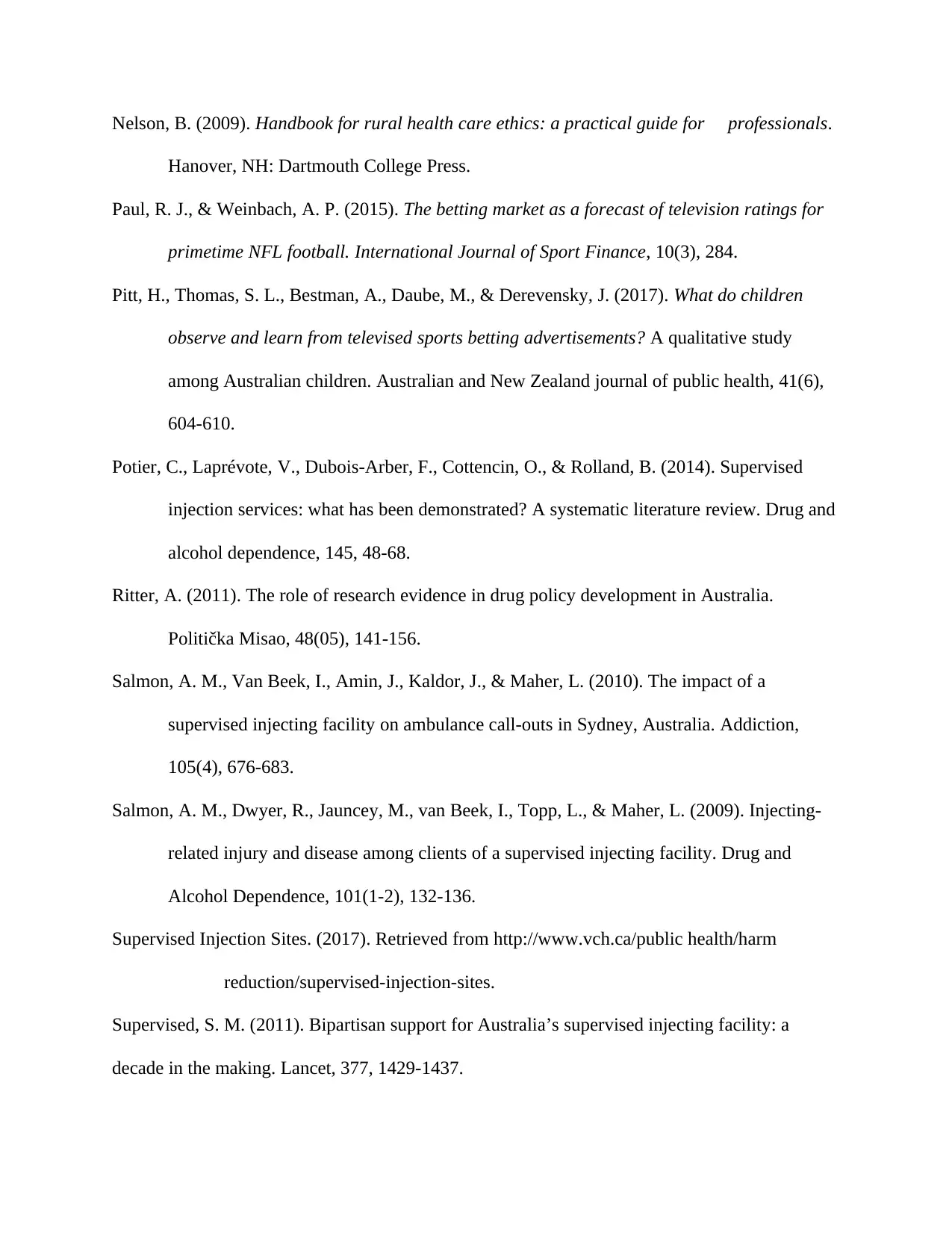
Nelson, B. (2009). Handbook for rural health care ethics: a practical guide for professionals.
Hanover, NH: Dartmouth College Press.
Paul, R. J., & Weinbach, A. P. (2015). The betting market as a forecast of television ratings for
primetime NFL football. International Journal of Sport Finance, 10(3), 284.
Pitt, H., Thomas, S. L., Bestman, A., Daube, M., & Derevensky, J. (2017). What do children
observe and learn from televised sports betting advertisements? A qualitative study
among Australian children. Australian and New Zealand journal of public health, 41(6),
604-610.
Potier, C., Laprévote, V., Dubois-Arber, F., Cottencin, O., & Rolland, B. (2014). Supervised
injection services: what has been demonstrated? A systematic literature review. Drug and
alcohol dependence, 145, 48-68.
Ritter, A. (2011). The role of research evidence in drug policy development in Australia.
Politička Misao, 48(05), 141-156.
Salmon, A. M., Van Beek, I., Amin, J., Kaldor, J., & Maher, L. (2010). The impact of a
supervised injecting facility on ambulance call‐outs in Sydney, Australia. Addiction,
105(4), 676-683.
Salmon, A. M., Dwyer, R., Jauncey, M., van Beek, I., Topp, L., & Maher, L. (2009). Injecting-
related injury and disease among clients of a supervised injecting facility. Drug and
Alcohol Dependence, 101(1-2), 132-136.
Supervised Injection Sites. (2017). Retrieved from http://www.vch.ca/public health/harm
reduction/supervised-injection-sites.
Supervised, S. M. (2011). Bipartisan support for Australia’s supervised injecting facility: a
decade in the making. Lancet, 377, 1429-1437.
Hanover, NH: Dartmouth College Press.
Paul, R. J., & Weinbach, A. P. (2015). The betting market as a forecast of television ratings for
primetime NFL football. International Journal of Sport Finance, 10(3), 284.
Pitt, H., Thomas, S. L., Bestman, A., Daube, M., & Derevensky, J. (2017). What do children
observe and learn from televised sports betting advertisements? A qualitative study
among Australian children. Australian and New Zealand journal of public health, 41(6),
604-610.
Potier, C., Laprévote, V., Dubois-Arber, F., Cottencin, O., & Rolland, B. (2014). Supervised
injection services: what has been demonstrated? A systematic literature review. Drug and
alcohol dependence, 145, 48-68.
Ritter, A. (2011). The role of research evidence in drug policy development in Australia.
Politička Misao, 48(05), 141-156.
Salmon, A. M., Van Beek, I., Amin, J., Kaldor, J., & Maher, L. (2010). The impact of a
supervised injecting facility on ambulance call‐outs in Sydney, Australia. Addiction,
105(4), 676-683.
Salmon, A. M., Dwyer, R., Jauncey, M., van Beek, I., Topp, L., & Maher, L. (2009). Injecting-
related injury and disease among clients of a supervised injecting facility. Drug and
Alcohol Dependence, 101(1-2), 132-136.
Supervised Injection Sites. (2017). Retrieved from http://www.vch.ca/public health/harm
reduction/supervised-injection-sites.
Supervised, S. M. (2011). Bipartisan support for Australia’s supervised injecting facility: a
decade in the making. Lancet, 377, 1429-1437.
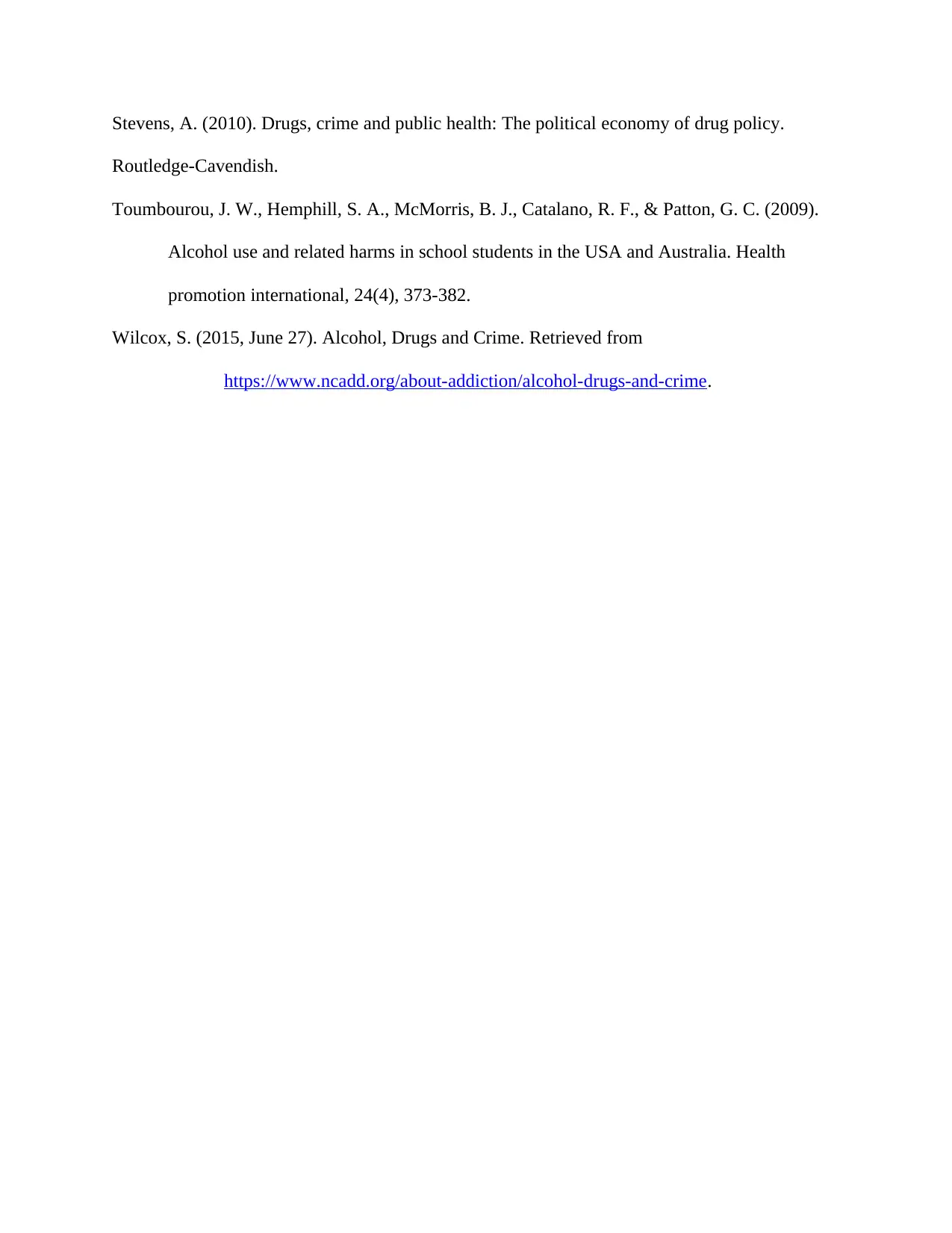
Stevens, A. (2010). Drugs, crime and public health: The political economy of drug policy.
Routledge-Cavendish.
Toumbourou, J. W., Hemphill, S. A., McMorris, B. J., Catalano, R. F., & Patton, G. C. (2009).
Alcohol use and related harms in school students in the USA and Australia. Health
promotion international, 24(4), 373-382.
Wilcox, S. (2015, June 27). Alcohol, Drugs and Crime. Retrieved from
https://www.ncadd.org/about-addiction/alcohol-drugs-and-crime.
Routledge-Cavendish.
Toumbourou, J. W., Hemphill, S. A., McMorris, B. J., Catalano, R. F., & Patton, G. C. (2009).
Alcohol use and related harms in school students in the USA and Australia. Health
promotion international, 24(4), 373-382.
Wilcox, S. (2015, June 27). Alcohol, Drugs and Crime. Retrieved from
https://www.ncadd.org/about-addiction/alcohol-drugs-and-crime.
⊘ This is a preview!⊘
Do you want full access?
Subscribe today to unlock all pages.

Trusted by 1+ million students worldwide
1 out of 9
Related Documents
Your All-in-One AI-Powered Toolkit for Academic Success.
+13062052269
info@desklib.com
Available 24*7 on WhatsApp / Email
![[object Object]](/_next/static/media/star-bottom.7253800d.svg)
Unlock your academic potential
Copyright © 2020–2025 A2Z Services. All Rights Reserved. Developed and managed by ZUCOL.



